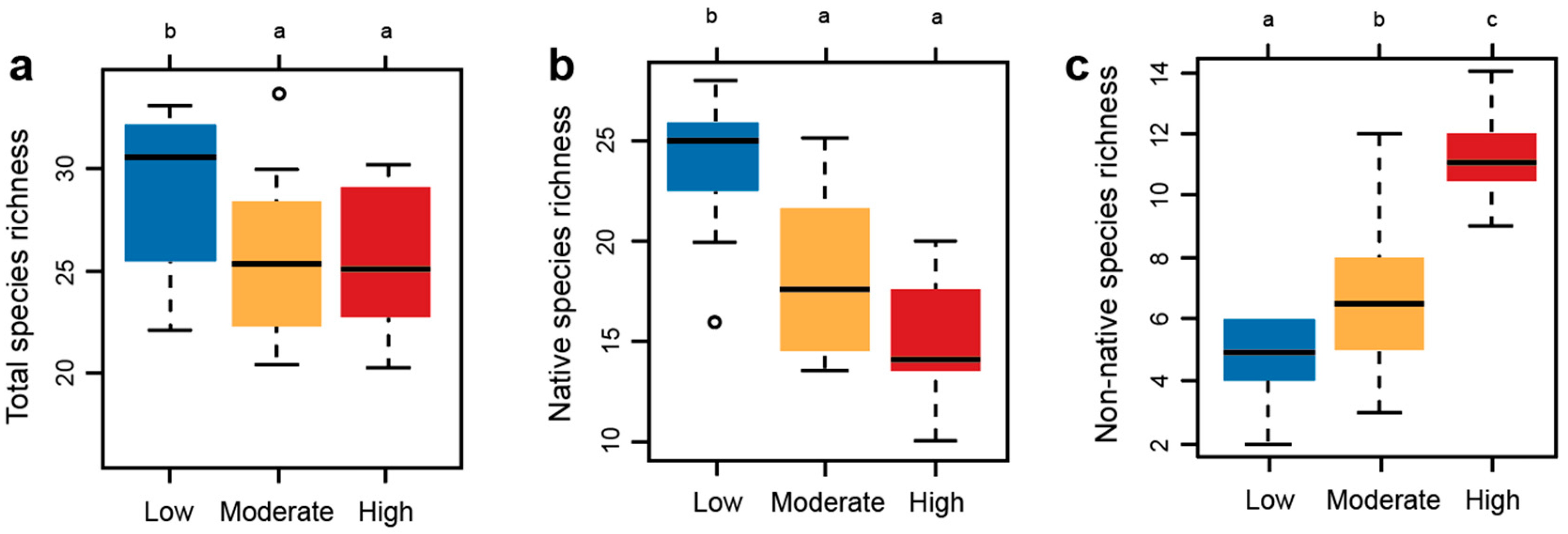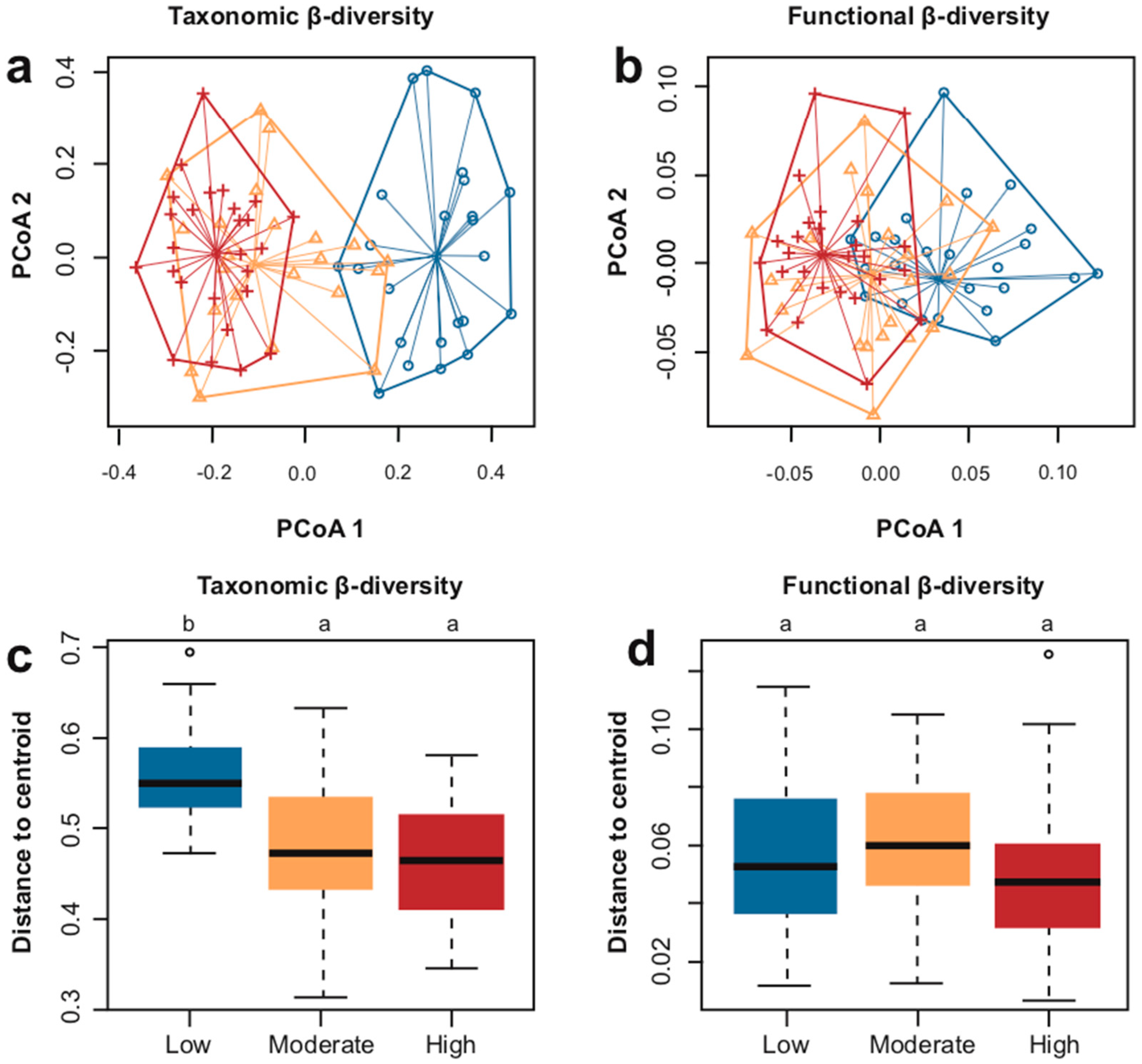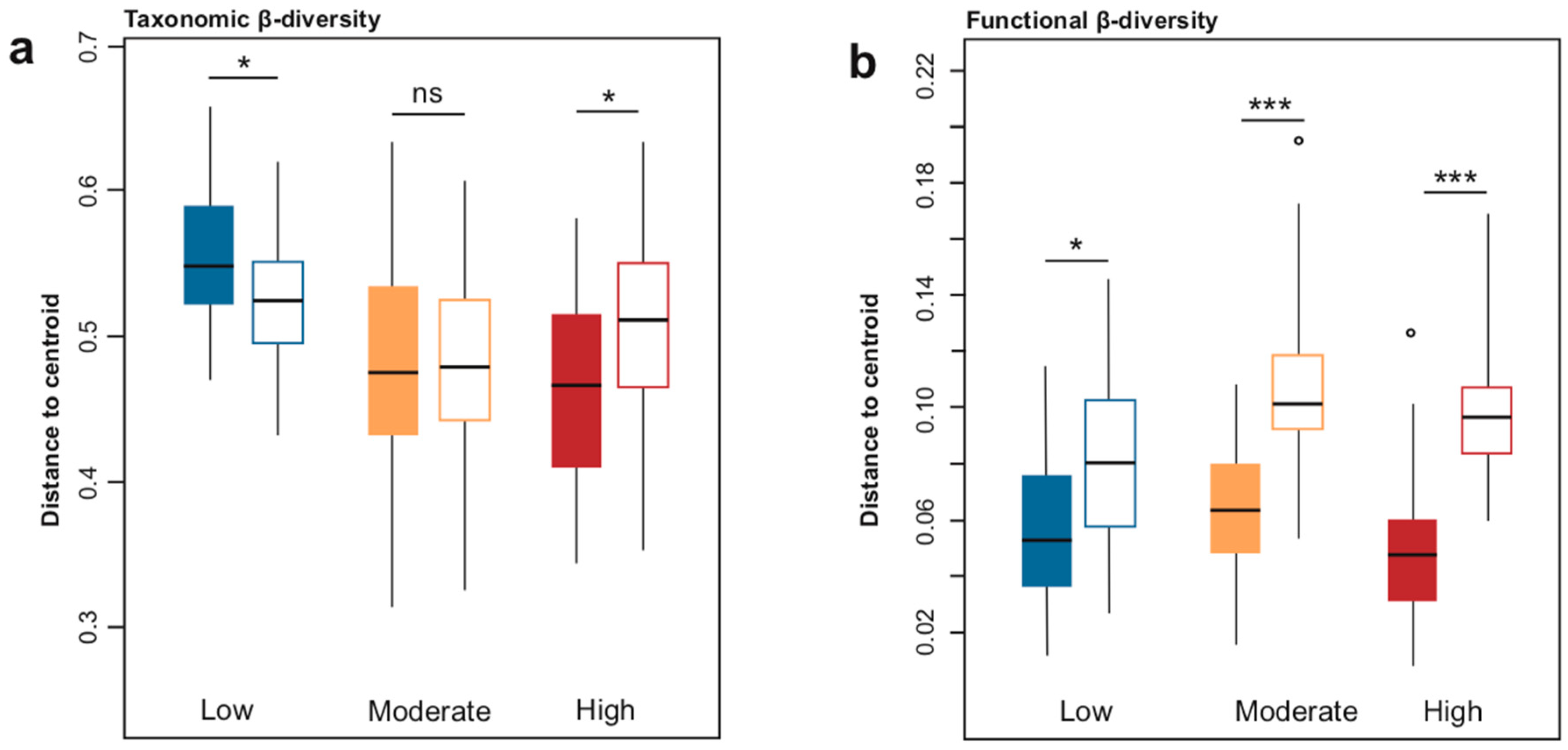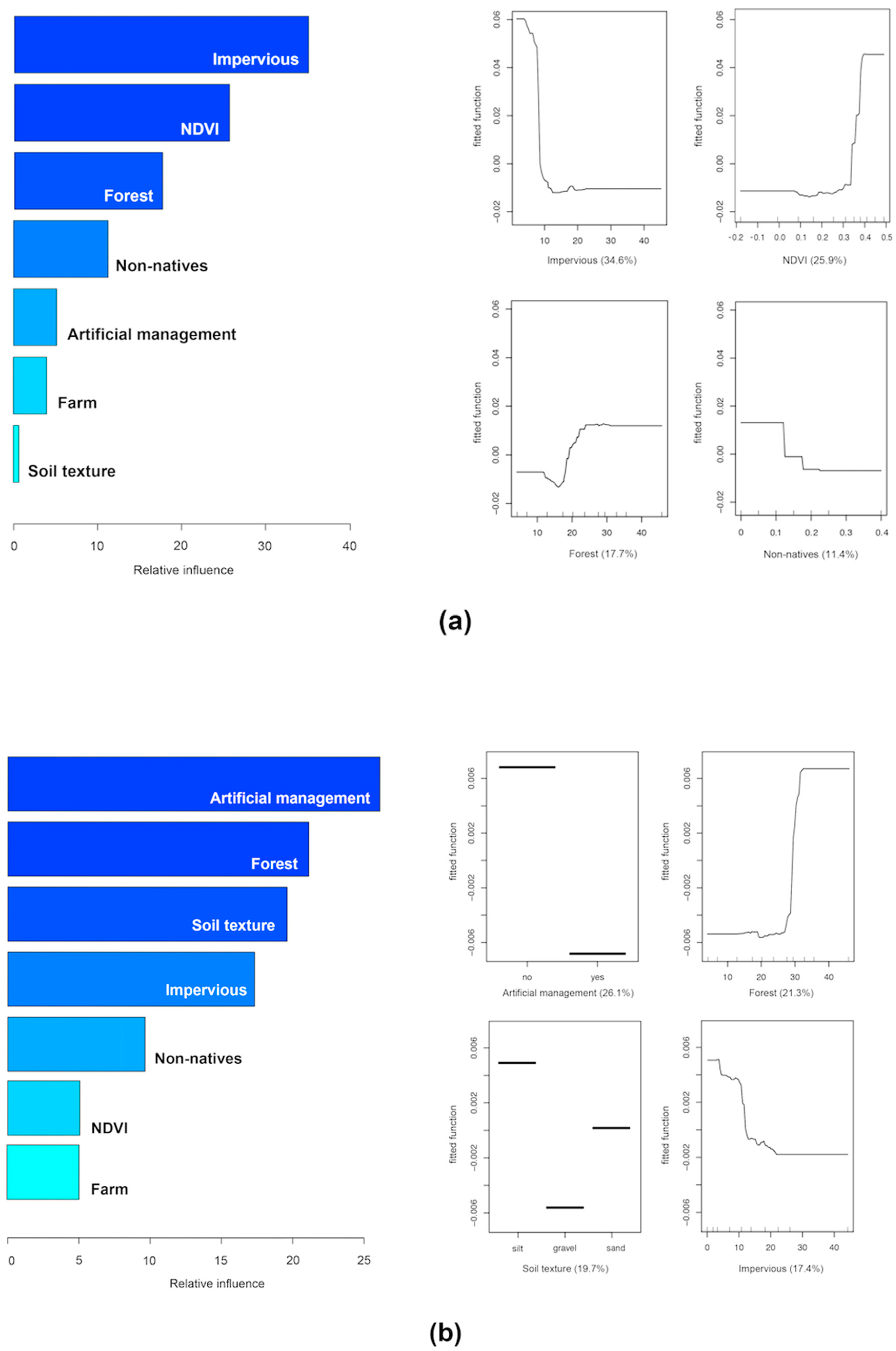Effect of Anthropogenic Disturbance on Floristic Homogenization in the Floodplain Landscape: Insights from the Taxonomic and Functional Perspectives
Abstract
1. Introduction
2. Materials and Methods
2.1. Study Area
2.2. Field Sampling
2.3. Delineation of Sampling Area into Different Level of Habitat Degradation
2.4. Functional Traits
2.5. Land-Use (Land Cover) and Habitat Data
2.6. Statistical Analysis
2.6.1. α- and β-Diversity
2.6.2. Effect of Increase of Non-Native Species
2.6.3. Effect of Environmental Matrix on β-Diversity
3. Results
3.1. Species Richness and Composition of Plant Assemblages
3.2. Taxonomic and Functional β-Diversity
3.3. The Role of Non-Native Species in β-Diversity
3.4. Joint Effects of Non-Native Species and Environmental Matrix
4. Discussion
4.1. Floristic Homogenization with Degradation Levels
4.2. Driving Factors of the Different Pattern of β-Diversity
4.3. Implication for Conservation
5. Conclusions
Supplementary Materials
Author Contributions
Funding
Acknowledgments
Conflicts of Interest
References
- McKinney, M.L.; Lockwood, J.L. Biotic homogenization: A few winners replacing many losers in the next mass extinction. Trends Ecol. Evol. 1999, 14, 450–453. [Google Scholar] [CrossRef]
- Pino, J.; Font, X.; De Cáceres, M.; Molowny-Horas, R. Floristic homogenization by native ruderal and alien plants in north-east Spain: The effect of environmental differences on a regional scale. Glob. Ecol. Biogeogr. 2009, 18, 563–574. [Google Scholar] [CrossRef]
- Zeeman, B.J.; McDonnell, M.J.; Kendal, D.; Morgan, J.W. Biotic homogenization in an increasingly urbanized temperate grassland ecosystem. J. Veg. Sci. 2017, 28, 550–561. [Google Scholar] [CrossRef]
- Olden, J.D.; Rooney, T.P. On defining and quantifying biotic homogenization. Glob. Ecol. Biogeogr. 2006, 15, 113–120. [Google Scholar] [CrossRef]
- Olden, J.D.; LeRoy Poff, N.; Douglas, M.R.; Douglas, M.E.; Fausch, K.D. Ecological and evolutionary consequences of biotic homogenization. Trends Ecol. Evol. 2004, 19, 18–24. [Google Scholar] [CrossRef]
- Price, E.P.F.; Spyreas, G.; Matthews, J.W. Biotic homogenization of wetland vegetation in the conterminous United States driven by Phalaris arundinacea and anthropogenic disturbance. Landsc. Ecol. 2020, 35, 779–792. [Google Scholar] [CrossRef]
- Socolar, J.B.; Gilroy, J.J.; Kunin, W.E.; Edwards, D.P. How Should Beta-Diversity Inform Biodiversity Conservation? Trends Ecol. Evol. 2016, 31, 67–80. [Google Scholar] [CrossRef]
- Scanes, C.G. Chapter 19—Human Activity and Habitat Loss: Destruction, Fragmentation, and Degradation. In Animals and Human Society; Scanes, C.G., Toukhsati, S.R., Eds.; Academic Press: Cambridge, MA, USA, 2018; pp. 451–482. [Google Scholar] [CrossRef]
- Kowarik, I. Novel urban ecosystems, biodiversity, and conservation. Environ. Pollut. 2011, 159, 1974–1983. [Google Scholar] [CrossRef]
- Fischer, J.; Lindenmayer, D.B. Landscape modification and habitat fragmentation: A synthesis. Glob. Ecol. Biogeogr. 2007, 16, 265–280. [Google Scholar] [CrossRef]
- Knapp, S. Urbanization Causes Shifts of Species’ Trait State Frequencies—A Large Scale Analysis. In Plant Biodiversity in Urbanized Areas: Plant Functional Traits in Space and Time, Plant Rarity and Phylogenetic Diversity; Knapp, S., Ed.; Vieweg + Teubner: Wiesbaden, Germany, 2010; pp. 13–29. [Google Scholar] [CrossRef]
- Kowarik, I.; Säumel, I. Biological flora of Central Europe: Ailanthus altissima (Mill.) Swingle. Perspect. Plant Ecol. Evol. Syst. 2007, 8, 207–237. [Google Scholar] [CrossRef]
- McKinney, M.L. Urbanization as a major cause of biotic homogenization. Biol. Conserv. 2006, 127, 247–260. [Google Scholar] [CrossRef]
- Blouin, D.; Pellerin, S.; Poulin, M. Increase in non-native species richness leads to biotic homogenization in vacant lots of a highly urbanized landscape. Urban Ecosyst. 2019, 22, 879–892. [Google Scholar] [CrossRef]
- Trentanovi, G.; von der Lippe, M.; Sitzia, T.; Ziechmann, U.; Kowarik, I.; Cierjacks, A. Biotic homogenization at the community scale: Disentangling the roles of urbanization and plant invasion. Divers. Distrib. 2013, 19, 738–748. [Google Scholar] [CrossRef]
- La Sorte, F.A.; McKinney, M.L.; PyŠEk, P. Compositional similarity among urban floras within and across continents: Biogeographical consequences of human-mediated biotic interchange. Glob. Chang. Biol. 2007, 13, 913–921. [Google Scholar] [CrossRef]
- Gong, C.; Chen, J.; Yu, S. Biotic homogenization and differentiation of the flora in artificial and near-natural habitats across urban green spaces. Landsc. Urban Plan. 2013, 120, 158–169. [Google Scholar] [CrossRef]
- Brice, M.-H.; Pellerin, S.; Poulin, M. Does urbanization lead to taxonomic and functional homogenization in riparian forests? Divers. Distrib. 2017, 23, 828–840. [Google Scholar] [CrossRef]
- Aronson, M.F.J.; Handel, S.N.; La Puma, I.P.; Clemants, S.E. Urbanization promotes non-native woody species and diverse plant assemblages in the New York metropolitan region. Urban Ecosyst. 2015, 18, 31–45. [Google Scholar] [CrossRef]
- Lougheed, V.L.; McIntosh, M.D.; Parker, C.A.; Stevenson, R.J. Wetland degradation leads to homogenization of the biota at local and landscape scales. Freshw. Biol. 2008, 53, 2402–2413. [Google Scholar] [CrossRef]
- Mayor, S.J.; Boutin, S.; He, F.; Cahill, J.F. Limited impacts of extensive human land use on dominance, specialization, and biotic homogenization in boreal plant communities. BMC Ecol. 2015, 15, 5. [Google Scholar] [CrossRef]
- Yang, J.; Yan, P.; He, R.; Song, X. Exploring land-use legacy effects on taxonomic and functional diversity of woody plants in a rapidly urbanizing landscape. Landsc. Urban Plan. 2017, 162, 92–103. [Google Scholar] [CrossRef]
- Brice, M.-H.; Pellerin, S.; Poulin, M. Environmental filtering and spatial processes in urban riparian forests. J. Veg. Sci. 2016, 27, 1023–1035. [Google Scholar] [CrossRef]
- Wang, G.-M.; Zuo, J.-C.; Li, X.-R.; Liu, Y.-H.; Yu, J.-B.; Shao, H.-b.; Li, Y.-Z. Low plant diversity and floristic homogenization in fast-urbanizing towns in Shandong Peninsular, China: Effects of urban greening at regional scale for ecological engineering. Ecol. Eng. 2014, 64, 179–185. [Google Scholar] [CrossRef]
- Tobias, N.; Monika, W. Does taxonomic homogenization imply functional homogenization in temperate forest herb layer communities? Plant Ecol. 2012, 213, 431–443. [Google Scholar] [CrossRef]
- Villéger, S.; Grenouillet, G.; Brosse, S. Functional homogenization exceeds taxonomic homogenization among European fish assemblages. Glob. Ecol. Biogeogr. 2014, 23, 1450–1460. [Google Scholar] [CrossRef]
- White, H.J.; Montgomery, W.I.; Storchová, L.; Hořák, D.; Lennon, J.J. Does functional homogenization accompany taxonomic homogenization of British birds and how do biotic factors and climate affect these processes? Ecol. Evol. 2018, 8, 7365–7377. [Google Scholar] [CrossRef] [PubMed]
- Pollock, L.J.; Morris, W.K.; Vesk, P.A. The role of functional traits in species distributions revealed through a hierarchical model. Ecography 2012, 35, 716–725. [Google Scholar] [CrossRef]
- Newbold, T.; Scharlemann, J.P.W.; Butchart, S.H.M.; Şekercioğlu, Ç.H.; Alkemade, R.; Booth, H.; Purves, D.W. Ecological traits affect the response of tropical forest bird species to land-use intensity. Proc. R. Soc. B Biol. Sci. 2013, 280, 20122131. [Google Scholar] [CrossRef]
- Williams, N.S.G.; Schwartz, M.W.; Vesk, P.A.; McCarthy, M.A.; Hahs, A.K.; Clemants, S.E.; Corlett, R.T.; Duncan, R.P.; Norton, B.A.; Thompson, K.; et al. A conceptual framework for predicting the effects of urban environments on floras. J. Ecol. 2009, 97, 4–9. [Google Scholar] [CrossRef]
- Williams, N.S.G.; Hahs, A.K.; Vesk, P.A. Urbanisation, plant traits and the composition of urban floras. Perspect. Plant Ecol. Evol. Syst. 2015, 17, 78–86. [Google Scholar] [CrossRef]
- Violle, C.; Navas, M.-L.; Vile, D.; Kazakou, E.; Fortunel, C.; Hummel, I.; Garnier, E. Let the concept of trait be functional! Oikos 2007, 116, 882–892. [Google Scholar] [CrossRef]
- Entwistle, N.S.; Heritage, G.L.; Schofield, L.A.; Williamson, R.J. Recent changes to floodplain character and functionality in England. Catena 2019, 174, 490–498. [Google Scholar] [CrossRef]
- Loiselle, A.; Pellerin, S.; Poulin, M. Impacts of urbanization and agricultural legacy on taxonomic and functional diversity in isolated wetlands. Wetl. Ecol. Manag. 2020, 28, 19–34. [Google Scholar] [CrossRef]
- Catford, J.A.; Jansson, R. Drowned, buried and carried away: Effects of plant traits on the distribution of native and alien species in riparian ecosystems. New Phytol. 2014, 204, 19–36. [Google Scholar] [CrossRef] [PubMed]
- Richardson, D.M.; Holmes, P.M.; Esler, K.J.; Galatowitsch, S.M.; Stromberg, J.C.; Kirkman, S.P.; Pyšek, P.; Hobbs, R.J. Riparian vegetation: Degradation, alien plant invasions, and restoration prospects. Divers. Distrib. 2007, 13, 126–139. [Google Scholar] [CrossRef]
- Johnson, S.E.; Mudrak, E.L.; Waller, D.M. Local increases in diversity accompany community homogenization in floodplain forest understories. J. Veg. Sci. 2014, 25, 885–896. [Google Scholar] [CrossRef]
- White, M.D.; Greer, K.A. The effects of watershed urbanization on the stream hydrology and riparian vegetation of Los Peñasquitos Creek, California. Landsc. Urban Plan. 2006, 74, 125–138. [Google Scholar] [CrossRef]
- Cao, Y.; Natuhara, Y. Effect of Urbanization on Vegetation in Riparian Area: Plant Communities in Artificial and Semi-Natural Habitats. Sustainability 2020, 12, 204. [Google Scholar] [CrossRef]
- O’Toole, A.C.; Hanson, K.C.; Cooke, S.J. The Effect of Shoreline Recreational Angling Activities on Aquatic and Riparian Habitat Within an Urban Environment: Implications for Conservation and Management. Environ. Manag. 2009, 44, 324–334. [Google Scholar] [CrossRef]
- Grella, C.; Renshaw, A.; Wright, I.A. Invasive weeds in urban riparian zones: The influence of catchment imperviousness and soil chemistry across an urbanization gradient. Urban Ecosyst. 2018, 21, 505–517. [Google Scholar] [CrossRef]
- Junk, W.J.; da Cunha, C.N.; Wantzen, K.M.; Petermann, P.; Strüssmann, C.; Marques, M.I.; Adis, J. Biodiversity and its conservation in the Pantanal of Mato Grosso, Brazil. Aquat. Sci. 2006, 68, 278–309. [Google Scholar] [CrossRef]
- Monk, W.A.; Compson, Z.G.; Choung, C.B.; Korbel, K.L.; Rideout, N.K.; Baird, D.J. Urbanisation of floodplain ecosystems: Weight-of-evidence and network meta-analysis elucidate multiple stressor pathways. Sci. Total Environ. 2019, 684, 741–752. [Google Scholar] [CrossRef] [PubMed]
- Wang, G.; Jiang, G.; Zhou, Y.; Liu, Q.; Ji, Y.; Wang, S.; Chen, S.; Liu, H. Biodiversity conservation in a fast-growing metropolitan area in China: A case study of plant diversity in Beijing. Biodivers. Conserv. 2007, 16, 4025–4038. [Google Scholar] [CrossRef]
- Opperman, J.J.; Luster, R.; McKenney, B.A.; Roberts, M.; Meadows, A.W. Ecologically Functional Floodplains: Connectivity, Flow Regime, and Scale1. JAWRA J. Am. Water Resour. Assoc. 2010, 46, 211–226. [Google Scholar] [CrossRef]
- Gilliam, F.S. The Ecological Significance of the Herbaceous Layer in Temperate Forest Ecosystems. BioScience 2007, 57, 845–858. [Google Scholar] [CrossRef]
- Lyon, J.; Sagers, C.L. Structure of herbaceous plant assemblages in a forested riparian landscape. Plant Ecol. 1998, 138, 1–16. [Google Scholar] [CrossRef]
- Mligo, C. Diversity and distribution pattern of riparian plant species in the Wami River system, Tanzania. J. Plant Ecol. 2017, 10, 259–270. [Google Scholar] [CrossRef][Green Version]
- Damgaard, C. Estimating mean plant cover from different types of cover data: A coherent statistical framework. Ecosphere 2014, 5, art20. [Google Scholar] [CrossRef]
- Tucker, C.J. Red and photographic infrared linear combinations for monitoring vegetation. Remote Sens. Environ. 1979, 8, 127–150. [Google Scholar] [CrossRef]
- Zhang, Y.; Odeh, I.O.A.; Han, C. Bi-temporal characterization of land surface temperature in relation to impervious surface area, NDVI and NDBI, using a sub-pixel image analysis. Int. J. Appl. Earth Obs. Geoinf. 2009, 11, 256–264. [Google Scholar] [CrossRef]
- Yengoh, G.T.; Dent, D.; Olsson, L.; Tengberg, A.E.; Tucker, C.J. Applications of NDVI for Land Degradation Assessment. In Use of the Normalized Difference Vegetation Index (NDVI) to Assess Land Degradation at Multiple Scales: Current Status, Future Trends, and Practical Considerations; Yengoh, G.T., Dent, D., Olsson, L., Tengberg, A.E., Tucker Iii, C.J., Eds.; Springer International Publishing: Cham, The Netherlands, 2016; pp. 17–25. [Google Scholar] [CrossRef]
- Wang, D.; Morton, D.; Masek, J.; Wu, A.; Nagol, J.; Xiong, X.; Levy, R.; Vermote, E.; Wolfe, R. Impact of sensor degradation on the MODIS NDVI time series. Remote Sens. Environ. 2012, 119, 55–61. [Google Scholar] [CrossRef]
- Griffith, J.A.; Martinko, E.A.; Whistler, J.L.; Price, K.P. Interrelationships among Landscapes, Ndvi, and Stream Water Quality in the U.S. Central Plains. Ecol. Appl. 2002, 12, 1702–1718. [Google Scholar] [CrossRef]
- Valladares, F.; Niinemets, Ü. Shade Tolerance, a Key Plant Feature of Complex Nature and Consequences. Annu. Rev. Ecol. Evol. Syst. 2008, 39, 237–257. [Google Scholar] [CrossRef]
- Van Doren, B.M.; Horton, K.G.; Dokter, A.M.; Klinck, H.; Elbin, S.B.; Farnsworth, A. High-intensity urban light installation dramatically alters nocturnal bird migration. Proc. Natl. Acad. Sci. USA 2017, 114, 11175. [Google Scholar] [CrossRef]
- Lockaby, B.G.; Zhang, D.; McDaniel, J.; Tian, H.; Pan, S. Interdisciplinary research at the Urban–Rural interface: The West ga project. Urban Ecosyst. 2005, 8, 7–21. [Google Scholar] [CrossRef]
- Pennington, D.N.; Hansel, J.R.; Gorchov, D.L. Urbanization and riparian forest woody communities: Diversity, composition, and structure within a metropolitan landscape. Biol. Conserv. 2010, 143, 182–194. [Google Scholar] [CrossRef]
- Roncucci, N.; Nassi O Di Nasso, N.; Bonari, E.; Ragaglini, G. Influence of soil texture and crop management on the productivity of miscanthus (Miscanthus × giganteus Greef et Deu.) in the Mediterranean. GCB Bioenergy 2015, 7, 998–1008. [Google Scholar] [CrossRef]
- Baselga, A. Separating the two components of abundance-based dissimilarity: Balanced changes in abundance vs. abundance gradients. Methods Ecol. Evol. 2013, 4, 552–557. [Google Scholar] [CrossRef]
- Anderson, M.J.; Ellingsen, K.E.; McArdle, B.H. Multivariate dispersion as a measure of beta diversity. Ecol. Lett. 2006, 9, 683–693. [Google Scholar] [CrossRef]
- Anderson, M.J. A new method for non-parametric multivariate analysis of variance. Austral Ecol. 2001, 26, 32–46. [Google Scholar] [CrossRef]
- Friedman, J.; Hastie, T.; Tibshirani, R. Additive logistic regression: A statistical view of boosting (With discussion and a rejoinder by the authors). Ann. Stat. 2000, 28, 337–407. [Google Scholar] [CrossRef]
- Dormann, C.F.; Elith, J.; Bacher, S.; Buchmann, C.; Carl, G.; Carré, G.; Marquéz, J.R.G.; Gruber, B.; Lafourcade, B.; Leitão, P.J.; et al. Collinearity: A review of methods to deal with it and a simulation study evaluating their performance. Ecography 2013, 36, 27–46. [Google Scholar] [CrossRef]
- Laliberté, E.; Legendre, P.; Shipley, B. FD: Measuring Functional Diversity from Multiple Traits, and Other Tools for Functional Ecology. R Package, Version 1.0-12; 2014. Available online: https://cran.r-project.org/web/packages/FD/index.html (accessed on 11 June 2020).
- Oksanen, J.; Blanchet, F.G.; Kindt, R.; Legendre, P.; Minchin, P.R.; O’hara, R.B.; Simpson, G.L.; Solymos, P.; Stevenes, M.H.H.; Wagner, H. Vegan: Community Ecology Package. R Package, Version 2.5-2; 2018. Available online: https://cran.r-project.org/web/packages/vegan/index.html (accessed on 7 May 2020).
- Hijmans, R.J.; Philips, S.; Leathwick, J.; Elith, J. dismo: Species Distribution Modeling. R Package, Version 1.1-4; 2017. Available online: https://cran.r-project.org/web/packages/dismo/index.html (accessed on 19 June 2020).
- Rooney, T.P.; Olden, J.D.; Leach, M.K.; Rogers, D.A. Biotic homogenization and conservation prioritization. Biol. Conserv. 2007, 134, 447–450. [Google Scholar] [CrossRef]
- McKinney, M.L. Do Exotics Homogenize or Differentiate Communities? Roles of Sampling and Exotic Species Richness. Biol. Invasions 2004, 6, 495–504. [Google Scholar] [CrossRef]
- Rosenblad, K.C.; Sax, D.F. A new framework for investigating biotic homogenization and exploring future trajectories: Oceanic island plant and bird assemblages as a case study. Ecography 2017, 40, 1040–1049. [Google Scholar] [CrossRef]
- Miyawaki, S. Invasive alien plant species in riparian areas of Japan: The contribution of agricultural weeds, revegetation species and aquacultural species. Glob. Environ. Res. 2004, 8, 89–101. [Google Scholar]
- Okimura, T.; Mori, A.S. Functional and taxonomic perspectives for understanding the underlying mechanisms of native and alien plant distributions. Biodivers. Conserv. 2018, 27, 1453–1469. [Google Scholar] [CrossRef]
- Petsch, D.K. Causes and consequences of biotic homogenization in freshwater ecosystems. Int. Rev. Hydrobiol. 2016, 101, 113–122. [Google Scholar] [CrossRef]
- Dıaz, S.; Cabido, M. Vive la différence: Plant functional diversity matters to ecosystem processes. Trends Ecol. Evol. 2001, 16, 646–655. [Google Scholar] [CrossRef]
- Mayfield, M.M.; Bonser, S.P.; Morgan, J.W.; Aubin, I.; McNamara, S.; Vesk, P.A. What does species richness tell us about functional trait diversity? Predictions and evidence for responses of species and functional trait diversity to land-use change. Glob. Ecol. Biogeogr. 2010, 19, 423–431. [Google Scholar] [CrossRef]
- Kuussaari, M.; Bommarco, R.; Heikkinen, R.K.; Helm, A.; Krauss, J.; Lindborg, R.; Öckinger, E.; Pärtel, M.; Pino, J.; Rodà, F.; et al. Extinction debt: A challenge for biodiversity conservation. Trends Ecol. Evol. 2009, 24, 564–571. [Google Scholar] [CrossRef]
- McKinney, M.L. Urbanization, Biodiversity, and Conservation: The impacts of urbanization on native species are poorly studied, but educating a highly urbanized human population about these impacts can greatly improve species conservation in all ecosystems. BioScience 2002, 52, 883–890. [Google Scholar] [CrossRef]
- Hill, M.O.; Roy, D.B.; Thompson, K. Hemeroby, urbanity and ruderality: Bioindicators of disturbance and human impact. J. Appl. Ecol. 2002, 39, 708–720. [Google Scholar] [CrossRef]
- Collins, M.D.; Vázquez, D.P.; Sanders, N.J. Species-area curves, homogenization and the loss of global diversity. Evol. Ecol. Res. 2002, 4, 457–464. [Google Scholar]
- Walsh, C.J.; Roy, A.H.; Feminella, J.W.; Cottingham, P.D.; Groffman, P.M.; Morgan, R.P. The urban stream syndrome: Current knowledge and the search for a cure. J. N. Am. Benthol. Soc. 2005, 24, 706–723. [Google Scholar] [CrossRef]
- Harrison, S.; Davies, K.F.; Safford, H.D.; Viers, J.H. Beta diversity and the scale-dependence of the productivity-diversity relationship: A test in the Californian serpentine flora. J. Ecol. 2006, 94, 110–117. [Google Scholar] [CrossRef]
- Chase, J.M.; Ryberg, W.A. Connectivity, scale-dependence, and the productivity–diversity relationship. Ecol. Lett. 2004, 7, 676–683. [Google Scholar] [CrossRef]
- Rapport, D.J.; Regier, H.A.; Hutchinson, T.C. Ecosystem Behavior Under Stress. Am. Nat. 1985, 125, 617–640. [Google Scholar] [CrossRef]
- Rowhani, P.; Lepczyk, C.A.; Linderman, M.A.; Pidgeon, A.M.; Radeloff, V.C.; Culbert, P.D.; Lambin, E.F. Variability in Energy Influences Avian Distribution Patterns Across the USA. Ecosystems 2008, 11, 854–867. [Google Scholar] [CrossRef]
- Groffman, P.M.; Bain, D.J.; Band, L.E.; Belt, K.T.; Brush, G.S.; Grove, J.M.; Pouyat, R.V.; Yesilonis, I.C.; Zipperer, W.C. Down by the riverside: Urban riparian ecology. Front. Ecol. Environ. 2003, 1, 315–321. [Google Scholar] [CrossRef]
- Campbell, D.A.; Cole, C.A.; Brooks, R.P. A comparison of created and natural wetlands in Pennsylvania, USA. Wetl. Ecol. Manag. 2002, 10, 41–49. [Google Scholar] [CrossRef]
- Huang, L.; Dong, B.-C.; Xue, W.; Peng, Y.-K.; Zhang, M.-X.; Yu, F.-H. Soil Particle Heterogeneity Affects the Growth of a Rhizomatous Wetland Plant. PLoS ONE 2013, 8, e69836. [Google Scholar] [CrossRef]
- Erdős, L.; Kröel-Dulay, G.; Bátori, Z.; Kovács, B.; Németh, C.; Kiss, P.J.; Tölgyesi, C. Habitat heterogeneity as a key to high conservation value in forest-grassland mosaics. Biol. Conserv. 2018, 226, 72–80. [Google Scholar] [CrossRef]
- Chávez, V.; Macdonald, S.E. Partitioning vascular understory diversity in mixedwood boreal forests: The importance of mixed canopies for diversity conservation. For. Ecol. Manag. 2012, 271, 19–26. [Google Scholar] [CrossRef]
- Levine, J.M. A trail map for trait-based studies. Nature 2016, 529, 163–164. [Google Scholar] [CrossRef]
- Díaz, S.; Cabido, M.; Zak, M.; Martínez Carretero, E.; Araníbar, J. Plant functional traits, ecosystem structure and land-use history along a climatic gradient in central-western Argentina. J. Veg. Sci. 1999, 10, 651–660. [Google Scholar] [CrossRef]
- Watanabe, T.; Okuyama, M.; Fukamachi, K. A Review of Japan’s Environmental Policies for Satoyama and Satoumi Landscape Restoration. Glob. Environ. Res. 2012, 16, 125–135. [Google Scholar]






| Characteristic | High | Moderate | Low |
|---|---|---|---|
| Number of floodplains | 13 | 11 | 12 |
| Mean NDVI values | −0.11–0.17 | 0.17–0.4 | 0.4–0.58 |
| Location of floodplains | Ise City (Miyagawatutumi Park, Love River Park, Miyagawashinsui Park) | Watarai Cho area, Tsumura Cho area, Souchi Cho area | Taiki Cho area, Ōdai Town, Kawazoe station area |
| Proportion of impervious surface (%) | 25.47 | 12.97 | 5.31 |
| Human population | 96,387 | 15,439 | 11,603 |
| Total number of plots | 26 | 22 | 24 |
| Trait | Trait State |
|---|---|
| Life form | Annual forb; Perennial forb; Shrub; Fern |
| Height (cm) | 1–50; 51–100; 101–150; 151–200; More than 200 |
| Reproduction | Vegetative; Vegetative and seed; Seed |
| Shade tolerance | Intolerant; Mid-tolerant; Tolerant |
| Wetness level | Upland; Facultative upland; Facultative; Facultative riparian; Riparian |
| Growth rate | Rapid; Moderate; Slow |
| Seed bank | Transient; Persistent |
| Seed abundance | High; Medium; Low |
| Fertility requirement | High; Medium; Low |
| Seed dispersal | Wind; Water/gravity; animal, multiple |
| Family | Species | High (%) | Moderate (%) | Low (%) |
|---|---|---|---|---|
| Polygonaceae | Rumex acetosa (L.) | 66.7 | 54.2 | 58.3 |
| Asteraceae | Artemisia indica Willd. var. maximowiczii (Nakai)H. Hara | 75 | 70.8 | 25.0 |
| Asteraceae | Solidago altissima (L.) | 79.2 | 70.8 | 4.2 |
| Asteraceae | Erigeron annuus (L.) Pers. | 83.3 | 41.7 | 8.3 |
| Poaceae | Lolium multiflorum Lam. | 50.0 | 58.3 | 20.8 |
| Rosaceae | Rosa multiflora Thunb. | 58.3 | 33.3 | 37.5 |
| Poaceae | Miscanthus sacchariflorus | 37.5 | 41.7 | 45.8 |
| Fabaceae | Trifolium repens (L.) | 54.2 | 50 | 20.8 |
| Poaceae | Phragmites japonica | 25 | 37.5 | 41.7 |
| Poaceae | Festuca arundinacea Scherb. | 50 | 37.5 | 8.3 |
| Taxonomic Aspect | Functional Aspect | |||
|---|---|---|---|---|
| F Ratio | p-Value | F Ratio | p-Value | |
| β-diversity | 16.92 | <0.001 | 4.09 | 0.064 |
| Shift in composition | 3.34 | 0.009 | 2.15 | 0.037 |
| Predictors | Degradation Level | ||
|---|---|---|---|
| High | Moderate | Low | |
| Land-use and land cover | |||
| Impervious (%) | 25.47 ± 3.17 a | 12.97 ± 1.13 b | 5.31 ± 0.52 c |
| Forest (%) | 16.07± 1.76 c | 23.27 ± 2.07 b | 30.32 ± 1.68 a |
| Farm (%) | 10.61 ± 2.93 b | 9.94 ± 1.67 b | 16.34 ± 1.06 a |
| Soil texture | |||
| Gravel (%) | 19.81 ± 4.30 a | 21.69 ± 5.97 a | 22.58 ± 5.71 a |
| Sand (%) | 37.62 ± 5.45 a | 36.87 ± 6.29 a | 39.82 ± 1.66 a |
| Silt (%) | 42.57 ± 5.45 a | 41.44 ± 7.01 a | 37.59 ± 5.41 a |
| Invasion | |||
| Non-natives | 0.32 ± 0.05 a | 0.25 ± 0.03 b | 0.07 ± 0.01 c |
| Human disturbance | |||
| Artificial management (%) | 69.23 | 36.36 | 25 |
| NDVI value | 0.06 ± 0.02 c | 0.27± 0.02 b | 0.49 ± 0.01 a |
© 2020 by the authors. Licensee MDPI, Basel, Switzerland. This article is an open access article distributed under the terms and conditions of the Creative Commons Attribution (CC BY) license (http://creativecommons.org/licenses/by/4.0/).
Share and Cite
Cao, Y.; Natuhara, Y. Effect of Anthropogenic Disturbance on Floristic Homogenization in the Floodplain Landscape: Insights from the Taxonomic and Functional Perspectives. Forests 2020, 11, 1036. https://doi.org/10.3390/f11101036
Cao Y, Natuhara Y. Effect of Anthropogenic Disturbance on Floristic Homogenization in the Floodplain Landscape: Insights from the Taxonomic and Functional Perspectives. Forests. 2020; 11(10):1036. https://doi.org/10.3390/f11101036
Chicago/Turabian StyleCao, Yang, and Yosihiro Natuhara. 2020. "Effect of Anthropogenic Disturbance on Floristic Homogenization in the Floodplain Landscape: Insights from the Taxonomic and Functional Perspectives" Forests 11, no. 10: 1036. https://doi.org/10.3390/f11101036
APA StyleCao, Y., & Natuhara, Y. (2020). Effect of Anthropogenic Disturbance on Floristic Homogenization in the Floodplain Landscape: Insights from the Taxonomic and Functional Perspectives. Forests, 11(10), 1036. https://doi.org/10.3390/f11101036





